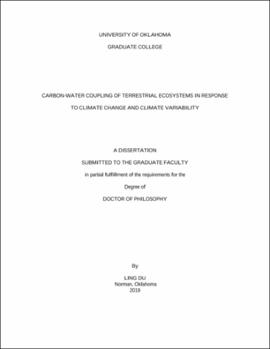| dc.description.abstract | Carbon and water cycles are two fundamental biophysical processes in terrestrial ecosystems. Rain use efficiency (RUE), defined as the ratio of ecosystem productivity to precipitation (PPT), and water use efficiency (WUE), defined as the ratio of ecosystem productivity to evapotranspiration (ET), are critical metrics of ecosystem function linking ecosystem carbon and water cycles. Under the context of global climate change and climate variability, much attention has been paid to the variation in RUE or WUE across biomes or species, and its responses to drought, elevated atmospheric CO2 concentration, and other environmental changes. However, due to differences in research method, study areas, and complexity in definitions, there is a lack of consensus on the coupling of carbon and water fluxes across different ecosystems and it’s responses to climate change and climate variability. Chapter 1 reviews the current status of carbon-water coupling studies and raises the major scientific questions that will be addressed in the dissertation. Chapter 2 examined the spatiotemporal variations in coupling of gross primary production (GPP) to PPT, and water fluxes (ET and T (transpiration)) at site and global scales. In-situ climate, and carbon and water fluxes datasets from 111 FLUXNET sites, global climate data, and remote sensing based GPP and ET data were combined to explore the relationships of GPP to PPT, ET, and T across different ecosystems and under different hydroclimatic conditions. Generally, GPP had a saturating relationship with PPT, and was linearly coupled with ET and T. This strong carbon-water flux coupling could be further improved by the incorporation of vapor pressure deficit (VPD) at site level. The sensitivity of GPP to PPT increased in severe drought years and decreased in pluvial years. There was no obvious change in the sensitivity of GPP to ET or T under altered climate conditions. Chapter 3 identified extreme drought events globally based on rain-use efficiency [RUE; GPP/PPT]. Ecosystem RUE is expected to increase with decreasing precipitation to a maximum (RUEmax) during moderate drought and will likely decline when water shortage is beyond the tolerance of vegetation, leading to a loss of ecosystem function. In this chapter, the PPT at the RUEmax was identified as a threshold of extreme drought condition, and the deviation of the RUE in drought condition from the norms in non-drought condition was further tested to determine if it exceeds the normal variability. Well-known extreme drought events were detected, e.g. 2003 drought in Europe, 2002 and 2011 drought in the U.S., and 2010 drought in Russia. Moreover, the reduced carbon uptake caused by extreme droughts (0.14±0.03 PgC/yr) could explain >70% of the GPP anomaly in drought-affected areas. Chapter 4 investigated the responses of WUE to environmental change in forests and grasslands in Northern Hemisphere. On the basis of Chapter 1, underlying water use efficiency (UWUE; GPP×VPD0.5/ET) incorporated the VPD effects on carbon assimilation and transpiration and hence provided an optimal indicator of carbon-water coupling in flux tower dataset. In this chapter, the interannual trend in UWUE and its responses to environmental factors were analyzed across 11 evergreen needleleaf forest (ENF) sites, 7 deciduous broadleaf forest (DBF) sites, and 9 grassland (GRA) sites. Results showed that, there was an obvious increase in UWUE in forests which was triggered by CO2 fertilization, increasing VPD, as well as the decreasing soil moisture in DBF. In GRA, the positive effect of CO2 fertilization on UWUE was offset by the negative effect of increasing soil moisture on UWUE, leading to no obvious trend in UWUE. Chapter 5 estimated the global ET at 8-day, 0.05° resolution from 2003 to 2015 based on GPP from Vegetation Photosynthesis Model (VPM), VPD estimated from Atmospheric Infrared Sounder (AIRS), and biome-level UWUE parameters. Biome-level UWUE was derived from the FLUXNET2015 dataset at 8-day timescale. The ET was calibrated and validated at the biome level against flux tower ET. The interannual trends in ET, GPP, and VPD were also analyzed at the global scale. There was an increasing trend in global ET over the study period (1.47 mm/yr). This ET product on the basis of carbon-water coupling showed better performance than a traditional approach, i.e. Penman-Monteith equation. Chapter 6 briefly summarizes the conclusions and perspectives from this dissertation. | en_US |
